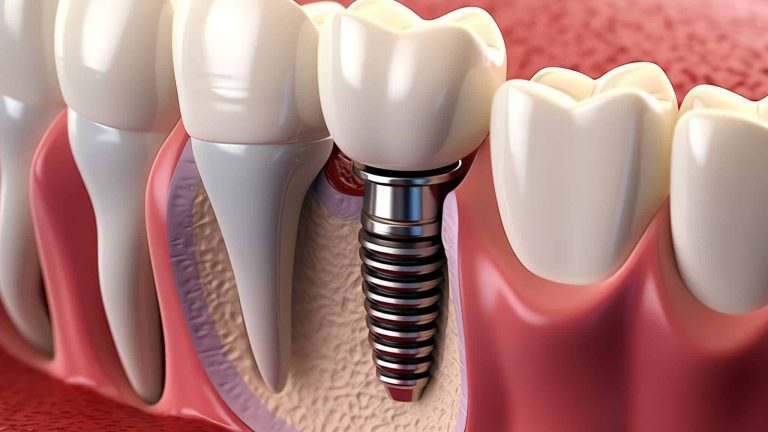Dental veneers have gained popularity as one of the most effective cosmetic treatments in dentistry. These thin sheets of porcelain or composite are placed on the front surface of teeth to improve their appearance. However, veneers not only serve an aesthetic purpose; they also offer functional benefits that can significantly improve the patient’s dental health and bite.
In this article, we will explore in detail how dental veneers can transform a smile, highlighting both their aesthetic role and the functional benefits they provide to oral health.
What Are Dental Veneers?
Dental veneers are thin sheets of porcelain or composite resin that are bonded to the front part of the teeth. They are designed to enhance the appearance of teeth by correcting aesthetic problems such as:
- Discolored or stained teeth
- Chipped or worn teeth
- Misaligned teeth or gaps between them
- Irregularly shaped or sized teeth
Unlike other treatments such as implants or crowns, veneers do not replace the tooth but act as a “covering” that enhances both appearance and function.
Aesthetic Benefits of Dental Veneers
Veneers are primarily known for their ability to enhance the appearance of a smile. Patients looking for a quick and long-lasting solution for a more attractive smile often choose this treatment. Here are some of the most prominent aesthetic benefits:
1. Permanent Teeth Whitening
While teeth whitening treatments can remove surface stains, veneers offer a longer-lasting solution for discolored teeth. Porcelain veneers do not stain easily and can maintain a bright tone for years, eliminating the need for repeated whitening treatments.
2. Correction of Imperfections
Veneers are an excellent option for correcting minor imperfections such as chipped, fractured, or worn teeth. By covering the front part of the tooth, veneers can transform a damaged tooth into one that looks perfectly uniform and healthy.
3. Improved Smile Symmetry
If you have misaligned teeth or gaps between them, veneers can provide a more symmetrical appearance without the need for orthodontics. Dentists can design veneers to correct alignment and close small gaps, creating a more balanced and attractive smile.
4. Customization
One of the great advantages of veneers is that they are fully customized. Dentists create veneers tailored to the size, shape, and color that best suit the patient. This ensures a result that looks completely natural, boosting the patient’s confidence in their smile.
Functional Benefits of Dental Veneers
Although veneers are best known for their aesthetic impact, they also offer several functional benefits that improve dental health and tooth function. Here are some key functional benefits:
1. Reinforces Weak Teeth
Teeth that are worn or slightly damaged can benefit from veneers, as they provide an additional layer of protection. While veneers do not replace crowns for severely damaged teeth, they can reinforce teeth that have suffered wear due to abrasion, bruxism, or small fractures.
2. Improvement of the Bite
When properly designed, veneers can correct minor bite issues or misaligned teeth, improving bite functionality. A more balanced bite not only enhances appearance but also reduces the risk of problems such as tooth wear and jaw tension.
3. Prevention of Tooth Wear
In some cases, misaligned or worn teeth are more prone to long-term damage. Veneers can act as a protective barrier, preventing further wear. This is particularly useful for patients with mild bruxism (teeth grinding), which can lead to excessive enamel wear.
4. Correction of Spaces and Mild Misalignment
While orthodontic treatments are the ideal choice for correcting major misalignment issues, veneers can help address minor spacing and misalignment, improving not only the smile’s aesthetics but also its functionality. By closing gaps, the risk of plaque buildup and related issues such as cavities and gum disease is reduced.
Types of Dental Veneers
There are two main types of dental veneers: porcelain veneers and composite resin veneers. Both have their advantages depending on the patient’s needs:
1. Porcelain Veneers
Porcelain veneers are the most popular option due to their durability and natural appearance. Porcelain is a highly stain-resistant material, allowing veneers to maintain their color and brightness for many years. Additionally, porcelain mimics the realistic appearance of tooth enamel, making them almost indistinguishable from natural teeth.
Advantages:
- Greater durability (can last 10-15 years with proper care)
- Stain-resistant
- Natural appearance
2. Composite Resin Veneers
Composite resin veneers are a more affordable alternative and can be placed in a single visit. While not as durable as porcelain, they can be easily repaired if chipped or damaged.
Advantages:
- Less invasive procedure (less enamel reduction needed)
- More affordable
- Easily repairable
The Dental Veneer Placement Process
The process for getting dental veneers usually requires two to three visits to the dentist, depending on the type of veneer and the necessary preparation. Below are the general steps of the process:
1. Consultation and Planning
The first step is a consultation with the dentist to assess the patient’s needs. The dentist will examine the mouth, take X-rays, and discuss the patient’s expectations regarding the shape, size, and color of the veneers. This is also when the dentist will determine if veneers are the right treatment or if another procedure would be better.
2. Tooth Preparation
Before placing the veneers, the tooth must be prepared by removing a small amount of enamel (usually less than 0.5 mm) from the front surface. This ensures that the veneers adhere properly and do not appear bulky.
For porcelain veneers, after preparation, an impression of the tooth is taken and sent to a dental laboratory where custom veneers are made. During this time, the patient may wear temporary veneers.
3. Veneer Placement
Once the veneers are ready, the dentist will temporarily place them to ensure the size, shape, and color are correct. If necessary, adjustments can be made at this point. After confirmation, the veneers are permanently bonded to the teeth.
4. Post-Care
After placement, it is important to maintain good oral hygiene to ensure the longevity of the veneers. Brushing twice a day, flossing, and regularly visiting the dentist are essential to keeping the veneers in good condition.
Who Are Candidates for Dental Veneers?
Dental veneers are an excellent option for patients looking to improve both the aesthetics and function of their teeth. However, not everyone is an ideal candidate. People with untreated cavities, advanced periodontal disease, or severely misaligned bites may need to address these issues before considering veneers.
Additionally, those with severe teeth grinding (bruxism) may not be the best candidates, as constant wear can damage the veneers over time.
Conclusion: Dental Veneers as a Comprehensive Solution
Dental veneers offer more than just aesthetic improvement. They not only transform the appearance of a smile but also protect weakened teeth, improve function, and can correct minor bite or alignment issues. As a customizable solution, veneers are tailored to the individual needs and desires of each patient, providing natural and long-lasting results.
At Clínicas La Guardia, our specialists are here to help you explore whether dental veneers are the right solution for you. Schedule your appointment today and take the first step toward a healthier, more functional, and beautiful smile.



